Revisiting The Times’s Coverage of the Duke Rape Case
THE official declaration of the innocence of three former Duke University lacrosse players accused of sexually assaulting a stripper triggered a flood of critical e-mails to the public editor. Many readers focused their ire on The Times’s massive Aug. 25 “portrait” of the case, or on the paper’s outspoken sports columnists. Others called on me to agree that a liberal bias favoring the dancer, who was African-American, had corrupted The Times’s coverage, or to urge the paper to apologize to the three young white men.After rereading the Times news stories published since my column on the Duke case a year ago, I decided to take a close look at the handling of the 5,700-word Page 1 article of Aug. 25, which some critics have made a proxy for the paper’s overall coverage. I found that the past year’s articles generally reported both sides, and that most flaws flowed from journalistic lapses rather than ideological bias.
An important caveat: As public editor, I have sought to avoid evaluating opinion articles because I haven’t found a universally acceptable yardstick for measuring what is good opinion and what is bad. So my review excluded Times columnists — including the sports commentators critical of Duke — who may have held forth on the case. Several columnists in The Times, it should be noted, in both the news columns and the opinion pages, have expressed strong support for the accused over the past year.
The controversial case started in March 2006 when the stripper said she had been gang-raped by three Duke lacrosse players after performing at a party organized by leaders of the team. Despite DNA evidence that didn’t match, the three were indicted in April and May by a grand jury in Durham, N.C., where Duke is located, at the behest of Michael B. Nifong, the district attorney. As formal complaints mounted about Mr. Nifong’s handling of the case, he asked the North Carolina attorney general in mid-January to take over the prosecution; the attorney general did so, and declared the accused innocent on April 11.The Aug. 25 review of the Duke case was nearly three times as long as any previous story about the investigation. The article made extensive use of 1,850 pages of prosecution evidence to which Duff Wilson, the straightforward lead reporter on the story, had obtained access. The key document — exclusive to The Times — was the 33-page typed “case notes” report of Sgt. Mark D. Gottlieb, a Durham police investigator.
Sergeant Gottlieb had acknowledged to defense lawyers, the Aug. 25 article reported, that he “took few handwritten notes, relying instead on his memory and other officers’ notes to write entries in his chronological report of the investigation.” Further complicating The Times’s decision to give substantial weight to the Gottlieb report, the document was in the last batch of evidence that Mr. Nifong turned over to the defense as required by the state’s criminal-case rules. That led one defense lawyer to call the report a “make-up document” that had been “written to try to make up for holes in the prosecution’s case,” the article stated.
Largely on the basis of the sergeant’s report, the Aug. 25 review was significantly less skeptical about Mr. Nifong’s case than a solid 1,600-word June 12 story that had described “a growing perception of a case in trouble.” The August article presented a summary paragraph — the “nut graf,” in newsroom parlance — whose final sentence amounted to The Times’s certifying the district attorney’s case as worthy of a trial.
“By disclosing pieces of evidence favorable to the defendants,” the paragraph stated, “the defense has created an image of a case heading for the rocks. But an examination of the entire 1,850 pages of evidence gathered by the prosecution in the four months after the accusation yields a more ambiguous picture. It shows that while there are big weaknesses in Mr. Nifong’s case, there is also a body of evidence to support his decision to take the matter to a jury.”
This overstated summary was a major flaw in the article that has overshadowed other worthwhile aspects of the story, such as the list, high up, of weaknesses in the prosecution case. Reading the article last August had left me concerned that Times journalists were not sufficiently skeptical in relying so heavily on the Gottlieb notes. I had voiced my concern then to Matthew Purdy, the investigations editor, who had assumed responsibility for news coverage of the Duke case in June. He assured me the paper was continuing to scrutinize Mr. Nifong’s case and behavior.
On Friday, Wilson introduced himself to me at the Nifong hearing, and said that while he “couldn’t go into details,” the “body of evidence” justifying to which the article referred revolved around SANE nurse-in-training Tara Levicy’s report. Yet I had looked at the same 1850 pages of discovery file that Wilson claimed to have examined for his article, and there is nothing in those 1850 pages that supports Wilson’s thesis that there was “a body of evidence to support [Nifong’s] decision to take the matter to a jury.” And, indeed, Cooper’s announcement that “no credible evidence” ever existed to substantiate Crystal Mangum’s claims gives the lie to the claim in Wilson’s article.
In one striking instance in the article, however, The Times decided Sergeant Gottlieb’s “case notes,” apparently based on his memory, were more credible than the handwritten notes of a fellow police investigator, Officer Benjamin Himan. Mr. Wilson said he had been told that the sergeant relied “largely” on Officer Himan’s handwritten notes when the two of them met the accuser on March 16 of last year to ask her to describe her attackers. Officer Himan’s handwritten notes show she described all three as chubby or heavyset, although one of the three eventual defendants was tall and skinny.
“In Sergeant Gottlieb’s version of the same conversation, however, her [the accuser’s] descriptions closely correspond to the defendants” and included one who was tall and skinny, the Aug. 25 article reported. So the Times article prominently listed Sergeant Gottlieb’s recollection of the accuser’s mentioning a tall and skinny attacker as one of three revelations from the prosecution files that showed the documents contained “evidence stronger than that highlighted by the defense.” Despite the paper’s full disclosure of the sergeant’s aversion to note-taking, I find that news judgment flawed — one allowing critics to foster a perception of the paper as leaning toward Mr. Nifong.
Defense lawyers have argued that the written medical reports do not support the charge of rape. But in addition to the nurse's oral description of injuries consistent with the allegation, Sergeant Gottlieb writes that the accuser appeared to be in extreme pain when he interviewed her two and a half days after the incident, and that signs of bruises emerged then as well.
...
During that interview, the woman, who is dark skinned, said bruises were beginning to show from the attack. A female officer took photographs and confirmed that ''she had the onset of new bruises present,'' Sergeant Gottlieb wrote.
Mr. Purdy told me last week that he still believes “we remained appropriately skeptical of Nifong’s case throughout.” But he added, “Looking back, we should have adjusted the ‘nut graf’ to give greater emphasis to the problems with the case, which is what the story did in its entirety.”Bill Keller, the executive editor, wrote to me in an e-mail about the weighing process that shaped the August article: “In hindsight, which is a hard thing to put aside, I’d have kept more to the tone of the June 12 piece. At the time we were trying to give sufficient prominence to what Duff had extracted with some difficulty — the evidence Nifong claimed justified his pursuit of this case — because that was actual new information.” He went on:
“At the same time we did not want to underplay the major holes in the case (which we itemized in considerable detail) and we did not want to treat our new material unskeptically, because there were serious questions about how reliable that evidence was — including a thinly veiled suggestion by the defense that it might have been fabricated. I think if you read the whole story you came away with a better understanding of what Nifong thought he had, but with continuing serious doubts about his case.”
Mr. Keller’s reference to “sufficient prominence” for material “extracted with some difficulty,” I would suggest, reflected the journalistic temptation to accord special weight to one’s exclusive information. But Mr. Purdy told me that the Gottlieb report was extensively cited in the Aug. 25 story because it “offered a fuller view of what Nifong had and perhaps what led him to believe he had a case.”
In fairness, Calame did address some of the flagrant errors in the NYT's coverage of the Nifong/Mangum Hoax. However, by refusing to offer even a hint of an apology to those injured by their flawed coverage and by continuing to rationalize and ignore many of those errors, Calame failed to take meaningful steps towards mitigating the enormous damage done by the New York Times.Several Duke supporters have complained about the attention The Times has given to the criticisms by Michael B. Nifong, the Durham County district attorney, of the refusal of any lacrosse team members to tell investigators what happened at the party. When those supporters stressed that three co-captains had gone to the police station for interviews and even volunteered to take lie-detector tests, it at first left me with some concern about fairness. But I think it has become more apparent, based on the public record, that the players have volunteered little eyewitness information. And that means Selena Roberts, a Times sports columnist, had ample reason for her recent concern about a "code of silence."
...
A final thought, based on my review of The Times's performance: Covering the legal proceedings that seem likely to focus on the extremely serious charges of sexual assault and kidnapping is vital. But the paper needs to keep an eye on the allegations and reports about the racial insults voiced by various players, and on the lacrosse team's seemingly flawed culture. If the rape and kidnapping charges do not hold up, the story doesn't end. The Times should be prepared to continue covering what is done about the racial-insult allegations, given the prominence of the team and the university.
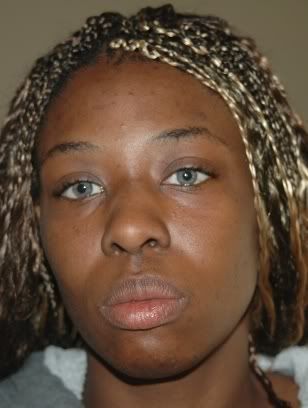







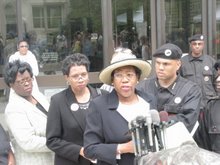
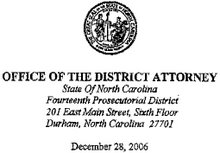
























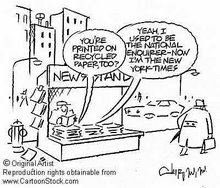


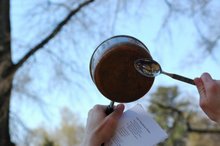









8 comments:
Don't be fooled for one minute by Calame's artful smoke and mirrors. The NYT isn't calling for an investigation of the Durham Police Dept. The NYT isn't asking hard questions about the DA, it isn't going to the bar, nor is it critical of the NC justice sytem at any level! The NYT gives little or no credence to the calls by several US Congressmen about a civil rights investigation - to them this is a JOKE. Try and find WORD ONE about that topic in the NYT. Make no mistake about it; the mighty NYT has an opinion about this case that they believe sells copy and it has NOTHING to do with the TRUTH as we know it on this sad case.
Carolyn says:
"As public editor...I haven’t found a universally acceptable yardstick for measuring what is good opinion and what is bad."
A reporter's hateful, biased opinion is shoved right under your nose but, even though you're a public editor, you still haven't 'found' out how to measure if it's good or bad? Well, that explains why you haven't 'found' out that your newspaper isn't supposed to give opinions, it's supposed to give facts.
But obviously you haven't found that, Calame. Which explains why you also haven't found out why readers of your rag are deserting in droves. I'd type up that reason, in really big letters, and put it under your nose - but you wouldn't find it.
All these words, all this justifying, when they *should* have just said, we were wrong...in light of the fact that Cooper declared the guys, "NOT GUILTY", anything less than an, I was wrong, just looks silly...but this *is* the NY Times, after all!
How about this one hard and fast rule: If it can end up with a potentially successful libel lawsuit, IT'S BAD OPINION!!! Idiot. I wouldn't trust the NY Times to tell me what day of the week it is, and I'd sooner take the Weekly World News seriously than their rag. Speaking of which, I should probably pick up a copy. I've been in need of a good laugh all month, and besides, it'll be refreshing to read a paper whose editors and writers are actually aware that their stories are full of shit and they write for purposes of entertainment. Just a thought...
I thought when I saw the the NYT headline on-line that the Times was going to write the real story. Well, I'm sending no messeage of congratulations to them, and this piece only served to confirm my subscription cancellation.
It's still amazing how they continue to miss the real story of corrupt juctice and politics in North Carolina.
It appears to me, and correct me if I am wrong. The NY Slimes is saying;
Our emphasis (nut graf) was on there being enough evidence to send these boys to trial.
But
We published all the facts in the case so a reasonable person should have inferred that the case was made up.
Thus
In hindsight since we were caught, and everybody complained about our twisting the facts 180 degrees we should have emphasized (nut graf) the correct interpatation of the evidence.
But hey we are the NYTimes what’s wrong with that? After all it is not the flawed journalism that was the real problem only the fact that it allowed critics to have the correct perception of us.
Tom E
5:18 PM --
Your last sentence could apply to every story that appears in the NYT. Those of us who have followed this story for over a year and know all the details know what a POS job the NYT did in reporting it and that includes the slimy editorials by Harvey Araton and Selena Roberts, too.
Now all the suits at the NYT, Keller, Calame, et. al., are trying to CYA as usual. You think the Nifong Hoax Scandal is the only story the NYT got this wrong? Hell no, they do it everyday. It's just that we don't know as many details about other stories so we can't debunk them the way we can this one. Doesn't mean they aren't equally as flawed news reporing. The NYT brings a bias to every story it prints. Paper of record, my ass.
"But I think it has become more apparent, based on the public record, that the players have volunteered little eyewitness information."
Meaning that the players didn't offer eyewitness information that supported the accuser's story. Not to mention that there are several accounts of Nifong refusing to hear any statements that didn't support the railroading.
That's not so much a code of silence. A code of silence is refusing to tell the truth when asked for the truth, not refusing to tell a story that fits a lie.
Post a Comment